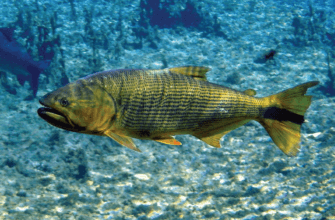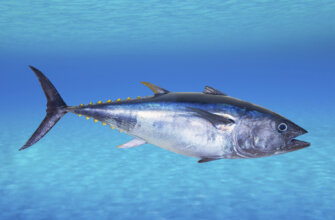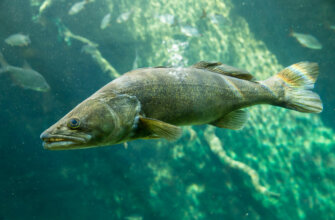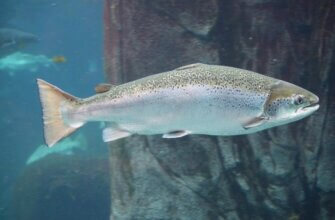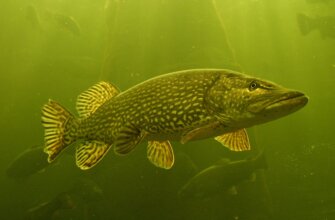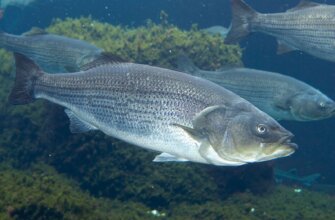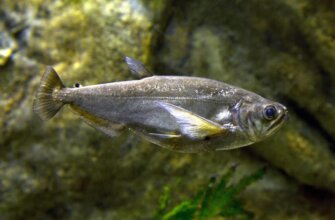Corvina, also known as croaker, is a species of fish that belongs to the Sciaenidae family. It is a popular food fish and is widely distributed in coastal waters around the world. The name “corvina” is used to describe several different species of fish, but in general, they share similar characteristics.
Corvina typically have an elongated body shape with a slightly compressed and silver-colored body. They have a single dorsal fin, which is often divided into two sections, and a forked tail.
One notable feature of corvina is their ability to produce loud sounds. They possess a specialized muscle, known as the “sonic muscle,” that allows them to vibrate their swim bladder rapidly. This produces a distinct croaking or drumming sound, which is used for communication and mating purposes.
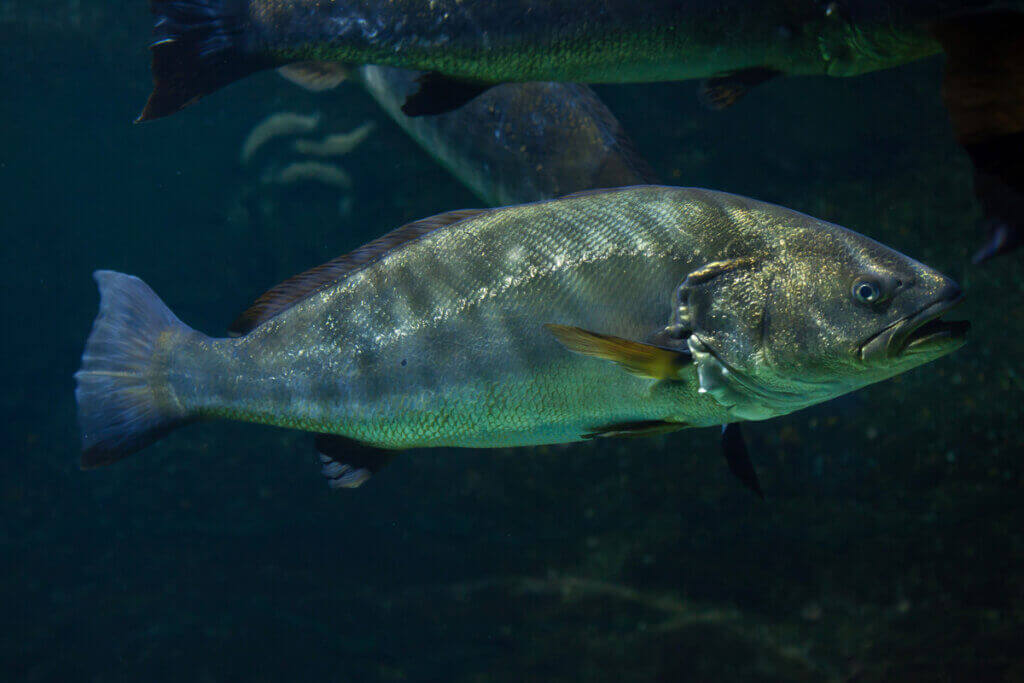
Corvina are primarily found in coastal waters, including estuaries, bays, and lagoons. They are known to be highly adaptable and can tolerate a wide range of salinity levels, which allows them to thrive in both saltwater and brackish environments. They are also known to migrate seasonally, moving closer to shore during spawning seasons.
In terms of culinary use, corvina is highly valued for its white, flaky meat, which is mild and slightly sweet in flavor. It is often considered a delicacy and is popular in many cuisines, particularly in coastal regions. Corvina can be prepared in various ways, including grilling, baking, or frying, and it is often featured in ceviche or fish tacos.
Species
The term “corvina” is used to refer to several different species of fish in the Sciaenidae family, commonly known as croakers.
Here are some notable species within the corvina/croaker group:
- Cynoscion regalis (Atlantic croaker). This species is found along the eastern coast of North America, ranging from Massachusetts to the Gulf of Mexico. It has a silvery-gray body with a slightly arched back and reaches an average length of 12-20 inches.
- Cynoscion nebulosus (spotted seatrout). Also known as speckled trout, this species is found in the coastal waters of the Atlantic Ocean, from the northeastern United States to the Gulf of Mexico. It has a speckled or spotted pattern on its body and can grow up to 40 inches in length.
- Larimus fasciatus (striped croaker). Found in the Pacific Ocean, particularly along the coasts of California and Baja California, Mexico. It has a silver body with distinct dark stripes along its sides and can grow up to 18 inches in length.
- Protonibea diacanthus (blackspotted croaker). This species is native to the Indo-Pacific region, including the coasts of Southeast Asia and Australia. It has a silver body with dark spots and can reach lengths of 20-30 inches.
These are just a few examples of the numerous species that fall under the corvina or croaker classification. Each species may have its own specific characteristics, distribution range, and culinary uses.
Appearance
Corvina, or croaker, species generally share some common appearance characteristics, although there may be variations among different species.
Here is a general description of the appearance of corvina:
- Body Shape. Corvina have an elongated body shape that is slightly compressed from side to side. Their bodies are typically streamlined, allowing them to navigate through water efficiently.
- Coloration. Corvina generally have a silvery or silver-gray coloration on their body. The shade of silver can vary slightly among species. In some cases, corvina may exhibit darker or lighter shades on their backs, sides, and bellies.
- Fins. They have a single dorsal fin located on their back. The dorsal fin is often divided into two distinct sections, with a notch or gap between them. The size and shape of the dorsal fin can differ between species. Corvina also have pectoral fins, pelvic fins, and an anal fin. Their tails are usually forked, aiding in swift swimming.
- Scales. Like most fish, corvina are covered in scales. The scales are typically small and overlapping, providing protection to their bodies.
- Distinctive Features. Some species of corvina may have specific distinctive features. For example, the Atlantic croaker (Cynoscion regalis) has a slightly arched back, while the spotted seatrout (Cynoscion nebulosus) has a speckled or spotted pattern on its body.
It’s important to note that there are different species of corvina, and their appearance may vary slightly. The details provided here offer a general overview of the appearance of corvina or croaker species.
Size and weight
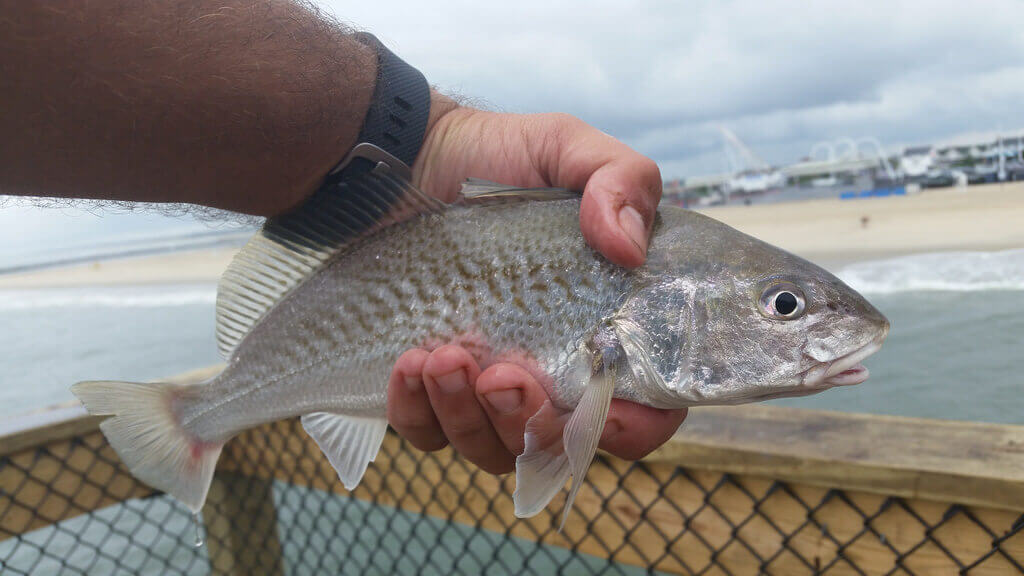
The size and weight of corvina, or croaker, can vary depending on the specific species.
Here is a general range of size and weight for corvina species:
- Atlantic Croaker. This species typically grows to an average length of 12-20 inches (30-50 cm). The weight of adult Atlantic croakers can range from 1 to 4 pounds (0.5 to 1.8 kg).
- Spotted Seatrout. Spotted seatrout can reach lengths of up to 40 inches (100 cm), but the average size is usually around 15-25 inches (38-64 cm). The weight of adult spotted seatrout can range from 2 to 10 pounds (0.9 to 4.5 kg), with larger individuals reaching weights of 15 pounds (6.8 kg) or more.
- Striped Croaker. The striped croaker typically grows to a length of 12-18 inches (30-46 cm) and weighs between 1 and 3 pounds (0.5-1.4 kg).
- Blackspotted Croaker. This species can grow larger compared to some other corvina species. Blackspotted croakers can reach lengths of 20-30 inches (50-75 cm) and weigh between 5 and 15 pounds (2.3-6.8 kg).
It’s important to note that these size and weight ranges are general estimates, and individual specimens can vary. Additionally, there are other species of corvina or croaker not mentioned here, and their sizes and weights may differ.
Diet
Corvina, or croaker, species are carnivorous and have a diet primarily consisting of various prey found in their habitat.
Here is an overview of the typical diet of corvina:
- Small Fish. Corvina commonly feed on smaller fish, including species like anchovies, sardines, herring, and other small forage fish. They are opportunistic predators and often target fish that are abundant in their environment.
- Crustaceans. Crustaceans, such as crabs and shrimps, are also part of the diet of corvina. These marine invertebrates serve as a source of nutrients and are often found in the coastal habitats where corvina reside.
- Mollusks. Some corvina species feed on mollusks like clams, mussels, and small snails. They have the ability to crush the shells of these prey items with their powerful jaws.
- Invertebrates. Corvina may also consume other small invertebrates like worms and small crustaceans that are available in their environment.
The specific composition of the diet can vary among different corvina species and their habitats. Their feeding habits may also vary depending on factors such as the availability of prey, seasonal changes, and their life stage.
It’s worth noting that corvina are known to be opportunistic feeders, adapting their diet to what is locally abundant. They are active predators that often use ambush tactics to catch their prey, striking quickly to capture their food.
Overall, corvina species play an important role in maintaining the balance of marine ecosystems by feeding on smaller organisms and participating in the food web of their respective habitats.
Behavior
Corvina, or croaker, species exhibit various behaviors that are influenced by their environment, life stage, and specific species characteristics.
Here are some general behaviors observed in corvina:
- Schooling Behavior. Many corvina species exhibit schooling behavior, where they gather in large groups or schools. This behavior provides them with several advantages, such as increased protection from predators, improved foraging efficiency, and enhanced reproductive success.
- Vocalization. One notable behavior of corvina is their ability to produce loud sounds, often referred to as “croaking” or “drumming.” They have a specialized muscle called the “sonic muscle” that allows them to vibrate their swim bladder rapidly, producing distinctive sounds. Vocalization is used for communication among individuals, particularly during courtship and spawning.
- Feeding Patterns. Corvina are opportunistic feeders and may exhibit different feeding patterns depending on the availability of prey. They may feed actively during certain times of the day or during specific tidal movements, targeting schools of smaller fish or forage organisms. They can also engage in bottom-feeding or foraging near the surface, depending on their preferred prey.
- Migratory Behavior. Some corvina species exhibit migratory behavior, moving between different habitats or regions at specific times of the year. Migration patterns may be influenced by factors such as reproduction, availability of food, and changes in water temperature. For instance, some species migrate closer to the shore or enter estuaries and coastal lagoons during spawning seasons.
- Reproductive Behavior. Corvina engage in various reproductive behaviors. During the spawning season, males may establish territories and produce distinct sounds to attract females. Females release their eggs into the water, and males release sperm to fertilize them. After fertilization, the eggs hatch into larvae, which eventually develop into juveniles.
- Predatory Behavior. Corvina are active predators and use various hunting techniques to capture their prey. They may ambush their prey by hiding and then swiftly striking or chase down smaller fish in open water. They have well-developed jaws and teeth that enable them to grasp and consume their prey effectively.
It’s important to note that specific behaviors can vary among different corvina species, as they adapt to their specific habitats and ecological niches. These general behaviors provide an overview of common traits observed in corvina, but further research into individual species can reveal more specific behaviors and adaptations.
Spawning
The spawning behavior of corvina, or croaker, species is an important aspect of their reproductive cycle.
While specific spawning behaviors can vary among different corvina species, here is a general overview of the spawning process:
- Timing. Corvina species typically have specific periods during the year when they engage in spawning activities. The timing can vary based on factors such as water temperature, photoperiod, and availability of food. Some species spawn during warmer months, while others may have specific spawning seasons associated with tides or lunar cycles.
- Spawning Aggregation. During the spawning period, corvina often form large aggregations or schools in specific spawning grounds, such as estuaries, coastal lagoons, or nearshore areas. These aggregations can consist of both males and females.
- Courtship and Mating. Male corvina may engage in courtship behavior to attract females. This can involve territorial displays, vocalizations, or physical interactions. Males produce distinctive sounds using their sonic muscles, which serve as a means of communication and courtship. Females select mates based on various factors, including male displays and the quality of spawning sites.
- Egg Release and Fertilization. Females release their eggs into the water column, while males release sperm to fertilize the eggs externally. The release of gametes often occurs simultaneously within the spawning aggregation, increasing the chances of successful fertilization.
- Egg Development. Once fertilized, the eggs of corvina float in the water column. The eggs are buoyant and contain a small amount of oil that helps keep them suspended. The development time for the eggs varies depending on the species and environmental conditions.
- Larval Stage. After hatching, corvina larvae enter a pelagic stage, where they are carried by currents and drift in open water. The larvae go through various developmental stages, gradually growing and developing their characteristic features.
- Juvenile Settlement. As the larvae develop, they eventually go through metamorphosis and transform into juvenile corvina. The juveniles settle in suitable habitats, such as seagrass beds, mangrove areas, or nearshore habitats, where they can find shelter and food resources.
It’s important to note that the specifics of spawning behavior, including the timing, location, and reproductive strategies, can vary among different corvina species. These general patterns provide an overview of the typical spawning process observed in corvina, but more specific information can be obtained by studying individual species in detail.
Fishing
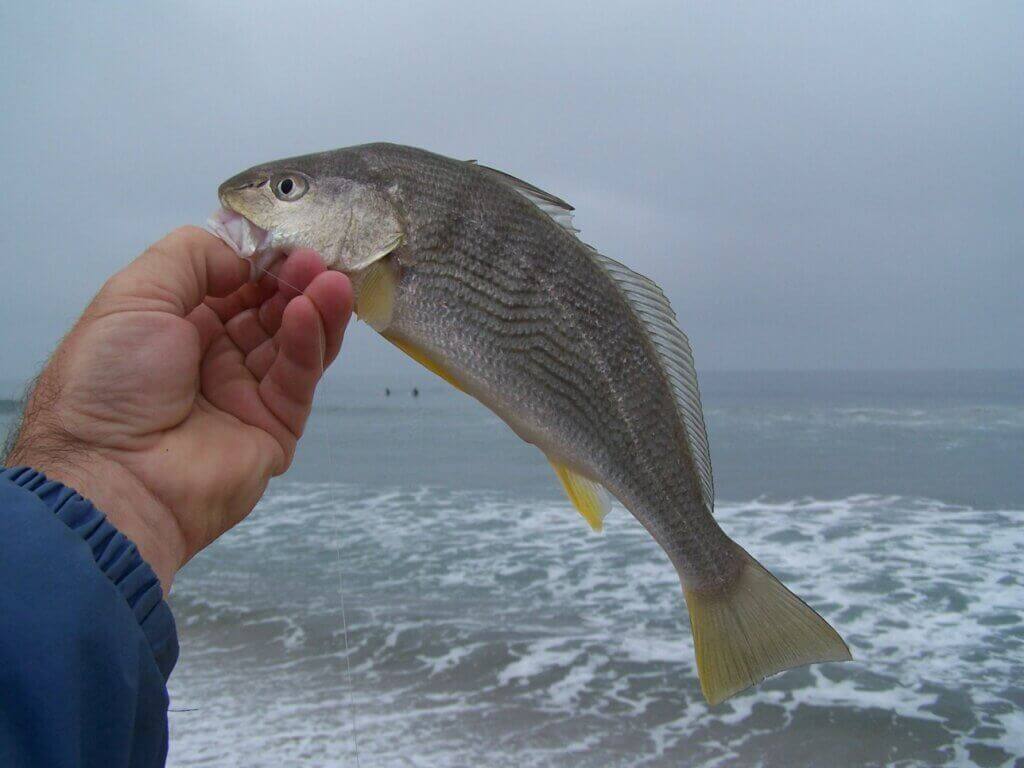
Fishing for corvina, or croaker, can be an enjoyable and rewarding experience for anglers.
Here are some considerations and tips for fishing corvina:
- Location. Corvina are typically found in coastal areas, including estuaries, bays, and nearshore waters. They are often associated with sandy or muddy bottoms and can be found near structures like jetties, piers, or submerged reefs. Researching local fishing reports or consulting with local anglers can help you identify productive fishing locations.
- Tackle and Gear. Medium to medium-heavy spinning or casting rods, typically 7-8 feet in length, are suitable for corvina fishing. Pair your rod with a reel that has a smooth drag system and sufficient line capacity. Use monofilament or braided fishing line in the 10-20 lb range, depending on the size of corvina you are targeting. A leader of fluorocarbon line or monofilament with a test strength of 15-30 lb can be used to reduce visibility and provide abrasion resistance. It’s also a good idea to have a variety of hooks, sinkers, and lures in your tackle box to adapt to different fishing conditions.
- Bait Selection. Corvina are opportunistic feeders and will readily take a variety of natural baits. Some popular bait options include live or cut baitfish (such as anchovies, sardines, or shrimp), squid, clams, or sand crabs. Adjust your bait size based on the average size of corvina in your fishing area.
- Lure Selection. Corvina can be targeted with a range of artificial lures. Soft plastic swimbaits, grubs, and jerkbaits in natural colors are effective choices. Jigging spoons, bucktail jigs, and topwater lures can also be productive, especially in shallow-water environments. Experiment with different retrieval speeds, pauses, and presentations to entice strikes.
- Fishing Techniques. Corvina are known for their sharp eyesight and can be skittish in clear water. Casting your bait or lure beyond the desired fishing area and slowly retrieving it can help avoid spooking the fish. If you’re fishing from the shore, consider wading out into the water to reach deeper channels or drop-offs where corvina may be lurking. Pay attention to tidal movements, as corvina are often more active during incoming or outgoing tides.
- Local Regulations. Before fishing for corvina, make sure to familiarize yourself with local fishing regulations and obtain the necessary fishing licenses or permits. Regulations may include size and bag limits, closed seasons, and gear restrictions. Adhering to these regulations helps preserve fish populations and ensures sustainable fishing practices.
Remember to practice catch-and-release when appropriate and handle corvina with care to minimize stress and increase their chances of survival if you plan to release them.
It’s important to note that fishing techniques and preferences can vary depending on your location, local conditions, and target corvina species. Consulting with local anglers or fishing guides can provide valuable insights specific to your fishing area.
Lures
When targeting corvina (croaker) with artificial lures, there are various types of lures that can be effective in enticing strikes.
Here are some popular lure options for corvina fishing:
- Soft Plastic Swimbaits. Soft plastic swimbaits are versatile lures that imitate baitfish, which are a common prey for corvina. Opt for swimbaits in natural colors like silver, white, or chartreuse. Rig them on a jig head or a weighted swimbait hook and retrieve them with a slow and steady retrieve, mimicking the swimming motion of a wounded or fleeing fish.
- Grubs and Jerkbaits. Grubs and jerkbaits in the 3-5 inch range can be effective for corvina. Use paddle-tail grubs or jerkbaits with a realistic baitfish profile. Colors like pearl, silver, or smoke tend to work well. Vary your retrieval speed and incorporate pauses or twitches to imitate injured or struggling prey.
- Jigging Spoons. Jigging spoons can be effective for targeting corvina, especially when they are holding near the bottom. Use silver or chrome-colored spoons with a fluttering action. Cast them out, let them sink to the desired depth, and then use a jigging motion to impart an enticing action. Lift the spoon off the bottom and allow it to flutter back down.
- Bucktail Jigs. Bucktail jigs are versatile lures that can be effective for corvina. Choose jigs with a natural hair or synthetic skirt, and in colors like white, chartreuse, or brown. Vary your retrieval speed, using a combination of steady retrieves, hops, and pauses to mimic the movements of prey.
- Topwater Lures. Topwater lures can be exciting to use when corvina are feeding near the surface or in shallow water. Walk-the-dog style lures, poppers, or surface plugs can attract aggressive strikes. Choose lures in natural colors like silver or white. Experiment with different retrieves, including steady retrieves, pauses, or a combination of pops and twitches.
When selecting lures, consider the size and color that best match the prevalent forage in your fishing area. It’s also important to adapt your lure selection based on the fishing conditions, such as water clarity, current, and the behavior of the corvina in your location.
Remember to experiment with different lure presentations, retrieve speeds, and patterns to determine what triggers the best response from the corvina in your fishing area. Pay attention to the feedback from the fish and adjust your approach accordingly.
Here are some examples of fishing lures that are commonly used for targeting corvina (croaker), along with their models and specifications:
- Zoom Super Fluke Soft Plastic Swimbaits:
- Model: Zoom Super Fluke.
- Length: 5 inches.
- Color Options: Pearl, White, Chartreuse.
- Rigging: Can be rigged on a jig head or weighted swimbait hook.
- Keitech Swing Impact Soft Plastic Swimbaits:
- Model: Keitech Swing Impact.
- Length: 4 or 5 inches.
- Color Options: Silver Flash, White, Electric Shad.
- Rigging: Typically rigged on a jig head or weighted swimbait hook.
- Yamamoto Single Tail Grubs:
- Model: Yamamoto Single Tail Grub.
- Length: 3 or 4 inches.
- Color Options: Smoke, Pearl, Silver.
- Rigging: Can be rigged on a jig head or weighted swimbait hook.
- Rapala X-Rap Jerkbaits:
- Model: Rapala X-Rap.
- Length: Varies (e.g., 3.5, 4, or 5 inches).
- Color Options: Silver, Silver Blue, Glass Ghost.
- Retrieve: Twitching, jerking, and pausing to imitate injured baitfish.
- Hopkins Shorty Jigging Spoons:
- Model: Hopkins Shorty Jigging Spoon.
- Length: Varies (e.g., 2.5 or 3 inches).
- Color Options: Silver, Chrome.
- Jigging Action: Fluttering action on the drop, lifting and dropping off the bottom.
- Spro Bucktail Jigs:
- Model: Spro Bucktail Jig.
- Weight: Varies (e.g., 1/4, 1/2, or 3/4 ounce).
- Color Options: White, Chartreuse, Brown.
- Retrieve: Vary the retrieve speed, incorporating hops, pauses, and steady retrieves.
- Heddon Super Spook Topwater Lures:
- Model: Heddon Super Spook.
- Length: 5 inches.
- Color Options: Silver Mullet, Bone, Clear.
- Retrieve: Walking-the-dog action, twitching the rod tip to create side-to-side movement.
These are just a few examples of lures commonly used for corvina fishing. Specific preferences may vary depending on the location, conditions, and angler’s personal experience. It’s always a good idea to research local fishing reports and consult with local anglers to determine the most effective lures for your specific fishing area.
Baits
When targeting corvina (croaker), there are various baits that can be effective in enticing strikes.
Here are some popular bait options for corvina fishing:
- Live Baitfish. Using live baitfish is a common and effective approach for targeting corvina. Anchovies, sardines, or small mullet are popular choices. Hook the live baitfish through the lips or behind the dorsal fin to allow it to swim naturally and attract the attention of corvina.
- Cut Bait. Cut bait refers to pieces of fish that are used as bait. Cut anchovies, sardines, or mullet can be effective when presented on a hook. Use fresh or frozen bait and cut it into strips or chunks. Allow the scent and movement of the cut bait to attract corvina.
- Shrimp. Shrimp is a natural prey item for corvina and can be a productive bait. Use fresh or frozen shrimp and rig them on a hook, either through the tail or by threading it along the body. Adjust the size of the shrimp to match the average size of corvina in your fishing area.
- Squid. Squid can be an enticing bait for corvina. Use fresh or frozen squid and cut it into strips or rings. Rig the squid on a hook, either by threading it or securing it with bait thread. The scent and texture of squid can attract corvina to your bait.
- Sand Crabs. Sand crabs, also known as sand fleas, are natural forage for corvina in sandy areas. Use a sand crab rake or scoop to collect live sand crabs from the beach. Hook them through the body or place them on a bait holder hook. Present the sand crabs near the bottom where corvina are likely to be feeding.
- Clams. Fresh or frozen clams can be effective bait for corvina. Use clam necks or smaller pieces of clam. Rig them on a bait holder hook or secure them with bait thread. Clams emit an attractive scent in the water, enticing corvina to feed.
When using natural baits, it can be beneficial to experiment with different presentations and fishing depths to determine what works best on a given day. Additionally, incorporating scent attractants or adding attractor beads to your bait setup can enhance its effectiveness.
Always ensure you are complying with local fishing regulations regarding bait collection and usage.
Rods
When selecting a fishing rod for corvina (croaker) fishing, there are a few factors to consider, such as the fishing technique, location, and personal preferences.
Here are some details to help you choose the right fishing rod for targeting corvina:
- Rod Type: A spinning rod is commonly used for corvina fishing due to its versatility and ease of use. However, if you prefer baitcasting reels, a baitcasting rod can also be suitable. Choose a rod type that you are comfortable using and matches your fishing style.
- Rod Length: The ideal rod length for corvina fishing typically ranges from 7 to 8 feet. A longer rod provides longer casting distances and better control when fighting fish, especially when fishing from shore or when longer casts are necessary. A shorter rod may offer more maneuverability in tighter spaces or when fishing from a boat.
- Power and Action: For corvina fishing, a medium to medium-heavy power rod is generally recommended. This power range provides enough strength to handle larger corvina while maintaining sensitivity to detect subtle bites. In terms of action, a fast or medium-fast action rod is preferred, as it allows for better hooksets and sensitivity.
- Material and Construction: Fishing rods are typically made from graphite, fiberglass, or a combination of both (composite). Graphite rods are lightweight, sensitive, and offer good strength, making them a popular choice. Fiberglass rods are more durable and have a slower action, providing better shock absorption. Composite rods offer a balance between the two materials, providing strength, sensitivity, and flexibility.
- Rod Guides: Look for a rod with quality guides that can handle the strain of casting and fighting fish. Stainless steel or ceramic guides are commonly used for their durability and smooth line flow. Make sure the guides are properly aligned and securely attached to the rod.
- Handle: The handle of the rod should be comfortable and provide a secure grip. Common handle materials include cork and EVA foam. Choose a handle length that allows for a comfortable two-handed grip when needed.
- Line Rating: Select a rod with an appropriate line rating to match the fishing conditions and the size of corvina you are targeting. A line rating of 10-20 lbs is generally suitable, but it can vary depending on the average size of corvina in your fishing area.
When choosing a fishing rod, consider your fishing location, casting distance requirements, and the average size of corvina you expect to encounter. It’s always beneficial to visit a local tackle shop or consult with experienced anglers who are familiar with corvina fishing in your specific area. They can provide additional guidance and recommend specific rod models that work well for corvina fishing in your region.
Here are some examples of fishing rods that are commonly used for targeting corvina (croaker), along with their models and specifications:
- Shimano Teramar West Coast Inshore Spinning Rod:
- Model: Shimano Teramar TMS80M.
- Length: 8 feet.
- Power: Medium.
- Action: Fast.
- Line Rating: 8-17 lbs.
- Lure Weight: 1/4 – 3/4 oz.
- Material: Graphite composite construction.
- St. Croix Mojo Inshore Spinning Rod:
- Model: St. Croix Mojo Inshore MIS70MF.
- Length: 7 feet.
- Power: Medium.
- Action: Fast.
- Line Rating: 8-17 lbs.
- Lure Weight: 1/4 – 3/4 oz.
- Material: Premium SCII graphite construction.
- Penn Battalion Inshore Spinning Rod:
- Model: Penn Battalion BATIN1220S70.
- Length: 7 feet.
- Power: Medium-Heavy.
- Action: Fast.
- Line Rating: 12-20 lbs.
- Lure Weight: 3/8 – 1 1/2 oz.
- Material: 30-ton graphite blank construction.
- Ugly Stik Elite Spinning Rod:
- Model: Ugly Stik Elite USESP702M.
- Length: 7 feet.
- Power: Medium.
- Action: Fast.
- Line Rating: 6-14 lbs.
- Lure Weight: 1/8 – 5/8 oz.
- Material: Graphite and fiberglass composite construction.
- Daiwa Coastal Salt Pro Surf Spinning Rod:
- Model: Daiwa Coastal Salt Pro CSPS1102MHFS.
- Length: 11 feet.
- Power: Medium-Heavy.
- Action: Fast.
- Line Rating: 15-30 lbs.
- Lure Weight: 1 – 5 oz.
- Material: High-modulus carbon graphite construction.
These are just a few examples of fishing rods commonly used for corvina fishing. Specific preferences may vary depending on your location, fishing conditions, and personal preference. It’s always a good idea to visit a local tackle shop or consult with experienced anglers in your area for further recommendations based on the specific requirements of corvina fishing in your region.
Dishes
Corvina (croaker) is a versatile fish that can be prepared in various delicious dishes.
Here are a few popular dishes featuring corvina:
- Grilled Corvina. Grilling corvina brings out its natural flavors and gives it a delightful smoky taste. Marinate the fish with olive oil, lemon juice, garlic, and herbs, then grill it until it’s cooked through and nicely charred on the outside.
- Baked Corvina with Herbs. Coat corvina fillets with a mixture of breadcrumbs, herbs (such as parsley, thyme, and dill), garlic, and olive oil. Place the fillets in a baking dish and bake them in the oven until they are golden and flaky.
- Corvina Ceviche. Ceviche is a popular dish that involves marinating fish in citrus juices, which “cooks” the fish without heat. Cut corvina into small pieces and marinate it in lime or lemon juice, along with onions, tomatoes, cilantro, and a touch of chili for some heat. Let it marinate in the refrigerator for a couple of hours until the fish turns opaque and firms up. Serve chilled as an appetizer or a light meal.
- Corvina Fish Tacos. Fry or grill corvina fillets until they are cooked through. Fill warm tortillas with the fish, and top them with shredded cabbage, sliced avocado, salsa, and a squeeze of lime. Serve with a side of Mexican rice and beans for a delicious and satisfying meal.
- Corvina Veracruz. In this dish inspired by Mexican cuisine, corvina is simmered in a flavorful tomato sauce with onions, garlic, olives, capers, and spices. The sauce infuses the fish with a tangy and savory taste. Serve it with rice or crusty bread to soak up the delicious sauce.
- Corvina Fish Soup. Use corvina fillets to make a flavorful fish soup. Simmer the fish in a broth made from vegetables, herbs, and spices. Add some diced potatoes, carrots, and other vegetables of your choice for a hearty and nutritious soup.
These are just a few examples of the many ways you can enjoy corvina in your culinary adventures. Feel free to explore different recipes and cooking techniques to find your favorite preparation method for corvina (croaker).

